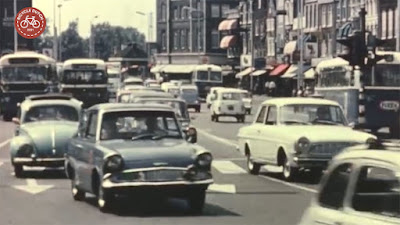A few days ago, Mark Wagenbuur re-posted an early post on his excellent blog, Bicycle Dutch. In it, he outlines the developments that led to the Netherlands' much-lauded bicycle infrastructure and culture.
 |
| Utrecht city center in 1929... |
Perhaps most important, he shows that his country wasn't always the cyclists' paradise one encounters today. Before World War II, bicycles were the main mode of transportation for many Dutch people. Photos show streets relatively free of cars and cyclists riding among, but not competing with, trams. After World War II, however, increasing affluence led people to foresake two wheels for four. Another photo from 1968 shows a street as clogged with motor traffic as any in an American city (though, it's hard not to notice, the vehicles are smaller). It was during the 1970s, he says, that the movements that led to today's system of bike lanes and other facilities began.
..
 |
| ...and in 1968 |
Activists and planners of that time also advocated for changes in city planning to encourage motor-free transportation and recreation. He shows motor vehicle-free central business districts, some in centuries-old areas of cities. As he points out--in contrast to the arguments of their American counterparts--business owners report increased business because a cyclist or pedestrian is more likely to stop by whereas a driver might pass by if they can't find a parking space.
But his post also points to another parallel with the US that might help to explain why such developments are slower in coming to America. For one, he mentions that in recent years, the amount of cycling in the Netherlands has stabilized--which isn't surprising when you realize that bicycles have outnumbered people for some time. (They do in my apartment, too!) Those statistics, though, have layers, and if you peel off one of them, you find that cycling has increased in urban areas but decreased in the countryside has decreased. I don't know what the numbers are for the US, but I suspect that there is a similar situation at work--or that, at any rate, most of the increase in American cycling has come in or near urban areas.
For another, he talks about the resistance to making city centers more auto-friendly. (One of the images is a rendition of a proposed highway that looks alarmingly like the ones in areas like Southern California and other auto-centric areas. Thankfully, it was never built.) While cycling declined for a couple of decades after World War II, remaining cyclists fought to make their country safer for riding. Also, making some city centers more auto-friendly meant, not only removing bike lanes or streets that were safe for cycling, but also some beloved buildings, some of them centuries old. When some of those structures were lost, people thought that perhaps the price of "progress" wasn't worth it.
While there is some interest in preserving historic structures in some American cities, on the whole the environment in the US is more amenable to large-scale development. Some of that has to do with citizens who still see building bigger buildings as "progress," but I suspect that it has at least as much to do with the fact that mega-developers have more influence on politics and the media, at the local as well as the national level, in the US.
Also, business and commercial districts in some American cities, especially the newer ones in the South and West, are auto-centric by design. In contrast, the older Dutch (and other European) city centers, with their narrower streets and smaller plazas, were created long before automobiles came along. So, I would suspect, making them more bicycle- and pedestrian-friendly would mean, at least to some degree, returning them to their original state. Or, at least, making them bicycle- and pedestrian- friendly doesn't require as much of a radical redesign as would be required in most American cities.
Finally, there is the matter of geography. The Netherlands is a much smaller country, and places are closer together. So people need less convincing to see that bicycling is a practical way to get to where they need to go--and that riding is simply fun. If someone lives 100 kilometers away from work, as many Americans do, no bike lane is going to convince them not to drive. At best, such a commuter might be enticed to ride his or her bike to a train or bus station--if indeed there are safe and secure parking facilities at the station. Or if there is a train or bus line at all. That is another area in which Dutch and other European people are better-served than Americans.
So, Mark Wagenbuur has done a service by showing that his country wasn't always the cycling Nirvana we see today. More important, he shows that it was once before a country of cyclists, but planners and ordinary citizens learned from their mistakes in emulating American transportation and city planning. Perhaps we can learn from our own mistakes and, although we can't go about it in the same way as the Dutch (or Danes or other Europeans), we can make this country more amenable for cyclists and pedestrians. It's one of the steps we need to take in order to keep from cooking ourselves (and most other life) on this planet!



